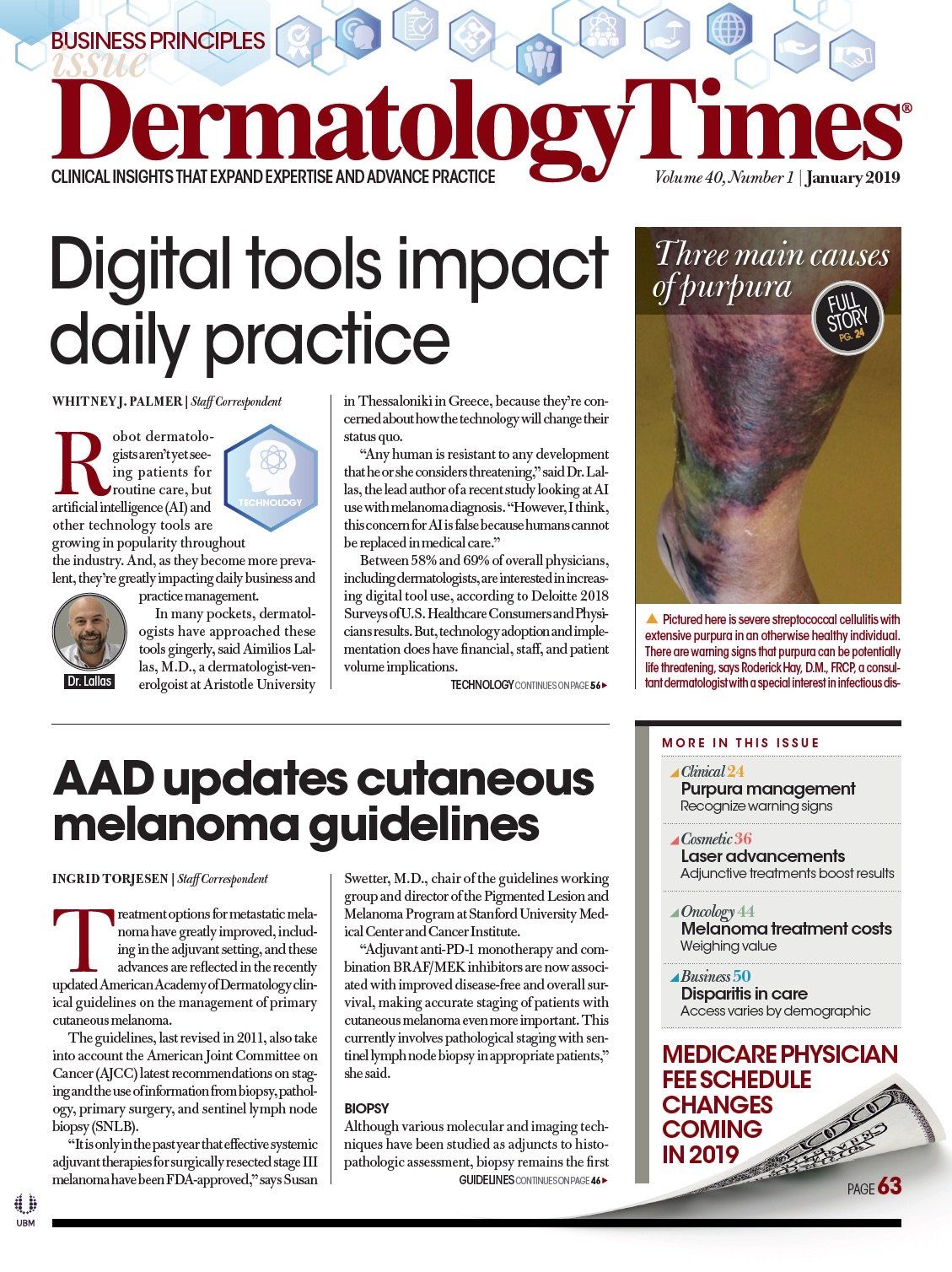- Case-Based Roundtable
- General Dermatology
- Eczema
- Chronic Hand Eczema
- Alopecia
- Aesthetics
- Vitiligo
- COVID-19
- Actinic Keratosis
- Precision Medicine and Biologics
- Rare Disease
- Wound Care
- Rosacea
- Psoriasis
- Psoriatic Arthritis
- Atopic Dermatitis
- Melasma
- NP and PA
- Skin Cancer
- Hidradenitis Suppurativa
- Drug Watch
- Pigmentary Disorders
- Acne
- Pediatric Dermatology
- Practice Management
- Prurigo Nodularis
- Buy-and-Bill
Publication
Article
Dermatology Times
Optimize clinical trial recruitment with digital platforms
Author(s):
Digital recruitment for clinical studies may be more effective than traditional methods, according to a new study.
Digital recruitment for clinical studies may be more effective than traditional methods, according to a new study. (Wladimir1804 - stock.adobe.com)

Randomized controlled trials (RCT) are the gold standard for studying the safety and efficacy of new treatments. The most important factor involved in these trials are the patients. Patients, however, are also one of the most unreliable factors creating significant struggles in terms of recruitment and dropout rates. Today, around 30% of the total clinical trial time used during development of a new drug can be attributed to patient recruitment(1). Only one-third of clinical trials manage to meet their target for patient recruitment within the predefined period for patient recruitment(2). There is an urgent need to improve these statistics and get more people to sign up for clinical trials.
For patients, RCT often provide an opportunity to get access to free medical care involving either standard treatment for their condition or an investigational drug. In fact, emerging research suggests that patients participating in clinical trials have better treatment outcomes than patients who have not participated in a clinical trial(3).
However, despite an extensive need for patients willing to participate in trials, only a fraction of eligible patients are offered the chance to participate. This is largely due to limited awareness amongst patients(4), and the fact that traditional methods for study recruitment focus mainly on recruiting subjects from a site’s existing patient flow or population(5). As a result, the demographics of the recruited population most often reflect the site’s patient population, but not necessarily the patient population at large(6).
Trial site start-up and management is expensive for sponsors(7), so most try to limit the number of sites. This may explain why patients who live outside the catchment area or are being treated elsewhere (which, by far, is the majority of eligible patients), may not be offered participation in a trial. Meanwhile, as sites are often involved in several trials with similar eligibility criteria, situations may arise where one trial is competing against other trials for recruitment from the same patient pool(8).
For pharmaceutical sponsors, delays in novel drug development could cost millions of dollars in lost revenue(9). For patients, delays in market approval of new drugs due to prolonged patient recruitment could mean reduced life quality, suboptimal treatment outcomes and potentially avoidable deaths. For payers, new drugs increase the market competition, which often results in more cost-efficient care. It’s in everyone’s interest to improve patient recruitment for clinical trials, but how do we solve this emerging problem?
ONLINE RECRUITMENT
Industries throughout the world are finding that the adoption of digitalization can optimize business operations making transactions convenient and efficient for customers. In 2017, 81% of people in developed countries-or, 48% of the world’s population-had internet access. In April 2018, 4.1 billion people used the internet(10), 3.2 billion of these people were active on social media(11) where Facebook was the most predominantly used service by its 2.2 billion users(12). In other words, social media and digital platforms posit an effective opportunity for reaching more patients that reflect the demographic of the general patient population.
There are several digital platforms designed to optimize patient recruitment (i.e. clinicaltrials.gov, trialx.com, antidote.me), building patient communities (i.e. clarahealth.com, patientslikeme.com, bethepartner.com) or through scanning electronic medical records (i.e. deep6.ai, epatientfinder.com).
However, to our knowledge only one company, Studies&Me of Denmark (www.studiesandme.com), has developed a solution that leverages qualified dermatologists to evaluate potential patients. After seeing an ad, patients are guided
to a customized landing page where they are presented with general information about clinical trials before entering a pre-qualification process via store-and-forward telemedicine involving a team of remote dermatologists and artificial intelligence.
This process is designed to direct patients to the sought after clinical study at the closest possible site. The process is made possible by a team of healthcare providers, digital developers and data scientists. The entire process can be completed in less than 48 hours: From clicking on the advertisement to signing up, pre-screening, and transferring contact information to a trial site.
PILOT STUDY
The Studies&Me platform was recently piloted as an add-on recruitment strategy in a “randomized, double-blind, placebo-controlled, phase three trial to evaluate the efficacy and safety of tralokinumab monotherapy in subjects with moderate to severe atopic dermatitis who are candidates for systemic therapy (ClinicalTrials.gov Identifier: NCT03131648).” Four study sites for this trial leveraged the platform (one in New York, N.Y.).
Social media campaigns for patient recruitment were published over the course of 150 days with over 15,000 people being directed to the customized landing page. Of these, over 1,500 signed up to be pre-screened for study eligibility. Patients answered the pre-screening questionnaire, provided consent and submitted a self-taken picture of a representative skin lesion. Of the patients living in proximity of the site, 46 patients were considered eligible to participate in the study by a remote dermatologist. The patients had a maximum travel distance of 10 miles to the site. Contact information of these patients were via an encrypted portal transferred to the study site.
All patients were contacted by phone or e-mail by the New York investigator where 27 patients responded, and 20 were scheduled for a screening visit. Of this group, nine of the scheduled screenings took place (the remaining patients either withdrew consent or didn’t show up). Finally, seven patients had a positive screening and all seven were randomized to participate in the trial. Of the 1,500 patients who signed up, additional patients were transferred and randomized with the three other sites involved in the recruitment initiative(13).
This pilot recruitment initiative highlights that digital recruitment platforms can offer an effective alternative to the traditional approach, even for studies with complex eligibility criteria. The screening failure rate of the digitally referred subjects in this pilot was similar to rates obtained in a recent, similar study of patients with severe atopic dermatitis (22% vs. 22%)(14), but when comparing the average number of days used per site per randomized subject, the time used by the New York site was less than one-third (21.4 vs. 65.5 days).
CONCLUSION
Key advantages of digital patient recruitment include fast and efficient recruitment. Key challenges include selecting sites that are motivated and capable of receiving pre-qualified subjects. And, who prioritize to contact the subjects immediately in order to optimize the odds of the subjects still willing to participate.
In fact, 30 out of the 46 patients in this pilot either never responded once contacted (even though they stated that they were interested in participation), withdrew consent or were no shows for screening(13). This demonstrates the need for engaging patients fast in the recruitment process making sure that subjects who are transferred from the digital platform are contacted and scheduled instantly for a screening visit.
Overall, the recruitment time of this phase three A trial was shortened by two weeks as a direct result of the Studies&Me platform. For the site in New York, seven patients with severe atopic dermatitis were randomized during three months, which is a significant improvement compared to previous trial recruitment initiatives. This could be attributed to the pre-qualification via teledermatology that the platform offers.
Author Affiliations: Drs. Katz and Misev are with the JUVA Skin & Laser Center, New York, N.Y. Drs. Eiken and Zibert are with LEO Innovation Lab, Copenhagen, Denmark.
REFERENCES
1. CMR International. Pharmaceutical R&D Factbook 2011, Thomson Reuters, May 2011
2. “Recruitment and retention of participants in randomised controlled trials: A review of trials funded and published by the United Kingdom Health Technology Assessment Programme.” Stephen J Walters, Inês Bonacho dos Anjos Henriques-Cadby, Oscar Bortolami et.al, BMJ Open. 2017; 7(3): e015276. DOI: 10.1136/bmjopen-2016-015276
3. “Participation in clinical trials improves outcomes in women’s health: A systematic review and meta-analysis.” Simrit K. Nijjar, Maria I. D’Amico, Noshali A. Wimalaweera et. al, BJOG 2017, May;124(6):863-871. DOI: 10.1111/1471-0528.14528.
4. “Challenges in recruitment and retention of clinical trial subjects.” Rashmi Ashish Kadam, Sanghratna Umakant Borde, Sapna Amol Madas et.al, Perspect Clin Res. 2016 Jul-Sep; 7(3): 137–143. DOI: 10.4103/2229-3485.184820.
5. “Practical tips for surgical research: How to optimize patient recruitment.” Achilleas Thoma, Forough Farrokhyar, Leslie McKnight et al. Can J Surg. 2010 Jun; 53(3): 205–210.
6. “A literature review on the representativeness of randomized controlled trial samples and implications for the external validity of trial results.” Tessa Kennedy-Martin, Sarah Curtis, Douglas Faries et al, Trials 2015 Nov 3;16:495. DOI: 10.1186/s13063-015-1023-4.
7. “Key cost drivers of pharmaceutical clinical trials in the United States.” Sertkaya A, Wong HH, Jessup A et al, Clin Trials. 2016 Apr;13(2):117-26. DOI: 10.1177/1740774515625964. Epub 2016 Feb 8.
8. “Site selection. Identifying high performing clinical sites. An Insider’s Insight.” 2017. Niche Science & Technology Ltd., UK https://bit.ly/2Ewzf2X
9. “Patient Recruitment: The Most Recognized Silent Driver of Clinical Development Costs.” International Pharmaceutical Industry. February 2013 Volume 5 Issue 1. https://bit.ly/2Ew0GtA
10. “Percentage of global population accessing the internet from 2005 to 2017, by market maturity,” Statista. https://bit.ly/2mqN75a
11. “Global digital population as of October 2018 (in millions),” Statista. https://bit.ly/2i1R8ZN
12. “Number of monthly active Facebook users worldwide as of 3rd quarter 2018 (in millions),” Statista. https://bit.ly/2daz7Yr
13. Data on file, Studies&Me
14. “Long-term management of moderate-to-severe atopic dermatitis with dupilumab and concomitant topical corticosteroids (LIBERTY AD CHRONOS CHRONOS): A 1-year, randomised, double-blinded, placebo-controlled, phase 3 trial.” Blauvelt A, de Bruin-Weller M, Gooderham M et al. Lancet. 2017, Jun 10;389(10086):2287-2303. DOI: 10.1016/S0140-6736(17)31191-1







